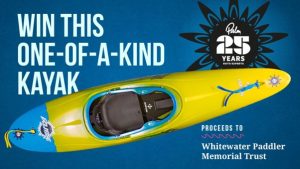
Brands are making real progress in reducing their environmental impact, tackling sustainability from multiple angles—better materials, smarter design, recycling initiatives, energy-efficient production, and increased transparency. But for consumers, it’s easy to get lost in a sea of eco-labels, bold claims, and overwhelming buzzwords. The outdoor and paddlesports industries are under pressure to clean up their act, and while most manufacturers are working towards better practices, sustainability is never a simple, clear-cut issue. There is no such thing as a “perfectly sustainable” product; every choice comes with trade-offs. This article serves as a tentative guide to looking beyond marketing and making more informed choices about environmental sustainability in paddlesports gear.
Key Areas of Sustainability
Brands can direct their sustainability efforts towards many areas: recycling, circularity, packaging, supply chains, harmful chemicals, repairability, and end-of-life solutions, to name a few. With so many factors at play, it’s easy to get lost in trying to determine what really matters for the environment. In reality, every step towards sustainability is a good step. No brand can be perfect, but understanding why a company prioritizes certain aspects over others is key to making informed choices.
Transparency Matters
A good place to start is by looking at how a brand presents its sustainability commitments. Most manufacturers now have a dedicated section on their website or their mission statement, but how easy is it to find out more about their commitments and their impact? Try searching for it now. A brand that is transparent and specific about its efforts is far more likely to be working towards meaningful sustainability rather than just using it as a selling point. That said, not all brands have fully communicated about their efforts yet. Transparency is key, but some companies may be making real progress behind the scenes without having put it into words.
Finding that dedicated section won’t tell you everything, but it will give you a good first impression of what the brand is doing and why it is focusing on those areas. Take a closer look: is the text full of vague promises, or does it provide clear facts, specific numbers, and measurable actions? Does sustainability feel like a genuine commitment, or just a marketing buzzword? One of the biggest challenges in assessing sustainability is “greenwashing,” when a brand highlights only the most eco-friendly aspects of a product while ignoring the rest. It’s easy to showcase only the positives while glossing over the bigger picture. So look for concrete steps rather than elusive statements, stay curious, and ask questions.
Recycling or Greenwashing?
Recycled materials provide a good example of why details matter. First, it’s important to differentiate between recycled and recyclable plastic. The former means the product is made from plastic that has already served another purpose, while the latter simply indicates that the product can be recycled—but doesn’t guarantee that it will be.
In kayak manufacturing, for example, does the brand clearly state what percentage of the product is made from recycled content? As Diego Zanga of Dragorossi and Rainbow Kayaks points out, recycled plastic can come from three sources: post-production waste (offcuts like cockpit trims), post-consumer waste (materials that have been used and discarded), and general plastic waste. The source matters because plastic from post-production or post-consumer waste can be used in much higher percentages (up to 100%), while plastic from general waste is typically limited to around 30% before mechanical properties are affected, requiring virgin plastic to make up the difference.
So, how does the recycling process actually work? And where does the material come from? To grind plastic into powder, a significant amount of material is needed. Does the brand actively collect and recycle old kayaks and offcuts, or do they source pre-ground recycled plastic from external suppliers? What happens if that supply runs out? Again, transparency matters. If a claim feels incomplete, it’s worth questioning what’s left unsaid.
The Full Life Cycle
Looking at the full lifespan of a product is just as important as assessing how it’s made. Does the company think beyond simply selling its products? Are they taking action to cover the entire life cycle of what they produce? Durability is one of the simplest and most effective ways to reduce waste. A truly sustainable product is one that lasts, and when it eventually wears out, it should be repairable. Some brands offer repair guides, take-back schemes, or buy-back programs for old gear. A quick test is to check how easy it is to find their return or repair page on their website. If it’s buried or difficult to understand, repairs—and meaningful sustainability—may not be a real priority.
Beyond repairability, what happens when products eventually reach the end of their life? Brands that consider the entire lifespan of their products shouldn’t be seen as expecting their gear to fail more often. Instead, they should be recognized for doing the right thing: investing extra time, money, and effort to ensure their products have minimal environmental impact. An example is Peak PS, which won the 2024 Paddle Sports Show Sustainability Award for its Circular Ready Program. This initiative rethinks paddlesports gear by designing products for full recyclability, using materials and patterning that allow for easy deconstruction at the end of their lifespan.
Industry-Wide Efforts
At last year’s Paddle Sports Show, various challenges of sustainability and circularity were brought into focus by Bob Timms of PGL. For the past two years, Timms has been running a conference at the show in collaboration with Kayak Session Publishing, bringing industry leaders together to discuss pressing environmental issues. What happens across the entire life cycle of a product? How can brands take greater responsibility? To address these questions, Timms, Jean-Yves Lapeyrere, founder of the European Confederation of Outdoor Employers, and the Paddle Sports Show have recently brought together a working group of manufacturers to develop better industry-wide solutions for recycling, upcycling, and reuse initiatives.
Should companies invest in in-house systems to process waste, or rely on external services? How can products be brought back for recycling without increasing transport costs and emissions? How is paddlesports equipment currently disposed of, and what improvements can be made? These are the kinds of challenges that demand collective action. As part of this effort, Timms also introduced the idea of a sustainability label, similar to B-Corp certification, to provide a structured framework for brands to implement their sustainability efforts more effectively.
Everything Matters
Environmental sustainability in paddlesports spans everything from chemical use and transportation to packaging and end-of-life solutions. But sustainability isn’t just about the environment; social and economic factors matter too. Prijon won the 2025 Paddle Sports Show Sustainability Award for its regional and eco-friendly approach—sourcing over 80% of components locally, generating renewable energy in-house, reducing transport emissions by manufacturing entirely in Germany and using recyclable, non-toxic materials as much as possible.
The reality is that no brand is perfect. At least not yet. No product is 100% sustainable, but that doesn’t mean we should give up or assume all efforts are meaningless. Consumers have a role to play too. The key is to stay informed, look beyond the marketing, and make choices that align with what we believe truly matters. Every decision, whether from consumers or the brands leading the way, contributes to the change we want to see and helps make paddlesports as sustainable as possible.




